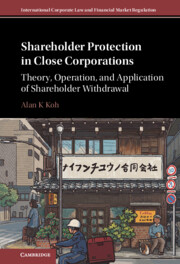 Shareholder Protection in Close Corporations
Shareholder Protection in Close Corporations Book contents
- Shareholder Protection in Close Corporations
- International Corporate Law and Financial Market Regulation
- Shareholder Protection in Close Corporations
- Copyright page
- Dedication
- Contents
- Figures and Tables
- Preface
- Acknowledgements
- Abbreviations
- I Introduction
- Part 1 Theory
- Part 2 Operation
- Part 3 Application
- Part 4 Conclusion
- IX Conclusions, Contributions, and Applications
- Bibliography
- Cases
- Legislation
- Index
IX - Conclusions, Contributions, and Applications
from Part 4 - Conclusion
Published online by Cambridge University Press: 14 October 2022
- Shareholder Protection in Close Corporations
- International Corporate Law and Financial Market Regulation
- Shareholder Protection in Close Corporations
- Copyright page
- Dedication
- Contents
- Figures and Tables
- Preface
- Acknowledgements
- Abbreviations
- I Introduction
- Part 1 Theory
- Part 2 Operation
- Part 3 Application
- Part 4 Conclusion
- IX Conclusions, Contributions, and Applications
- Bibliography
- Cases
- Legislation
- Index
Summary
Chapter IX summarizes this Book’s key findings and explores applications and extensions of the corporate law concepts and comparative law methodology developed in this Book. This Book contributes to legal scholarship in three ways. First, it establishes a coherent set of corporate law concepts and terminology that clarifies and expands our understanding of shareholder conflict and withdrawal across diverse jurisdictions. Second, it develops and applies a novel comparative law method (named the ‘tripartite method’). Third, I identify and analyse the phenomenon, which I call ‘spontaneous functional convergence’, in withdrawal law. This subtype of convergence occurs where jurisdictions appear to have – largely independently of other jurisdictions – developed legal regimes that are functionally similar but formally different using mostly, if not exclusively, domestic legal sources and inspirations. The spontaneous convergence observed in the withdrawal regimes of the target jurisdictions point to withdrawal as an evolutionary milestone for close corporation law.
Keywords
- Type
- Chapter
- Information
- Shareholder Protection in Close CorporationsTheory, Operation, and Application of Shareholder Withdrawal, pp. 289 - 303Publisher: Cambridge University PressPrint publication year: 2022
